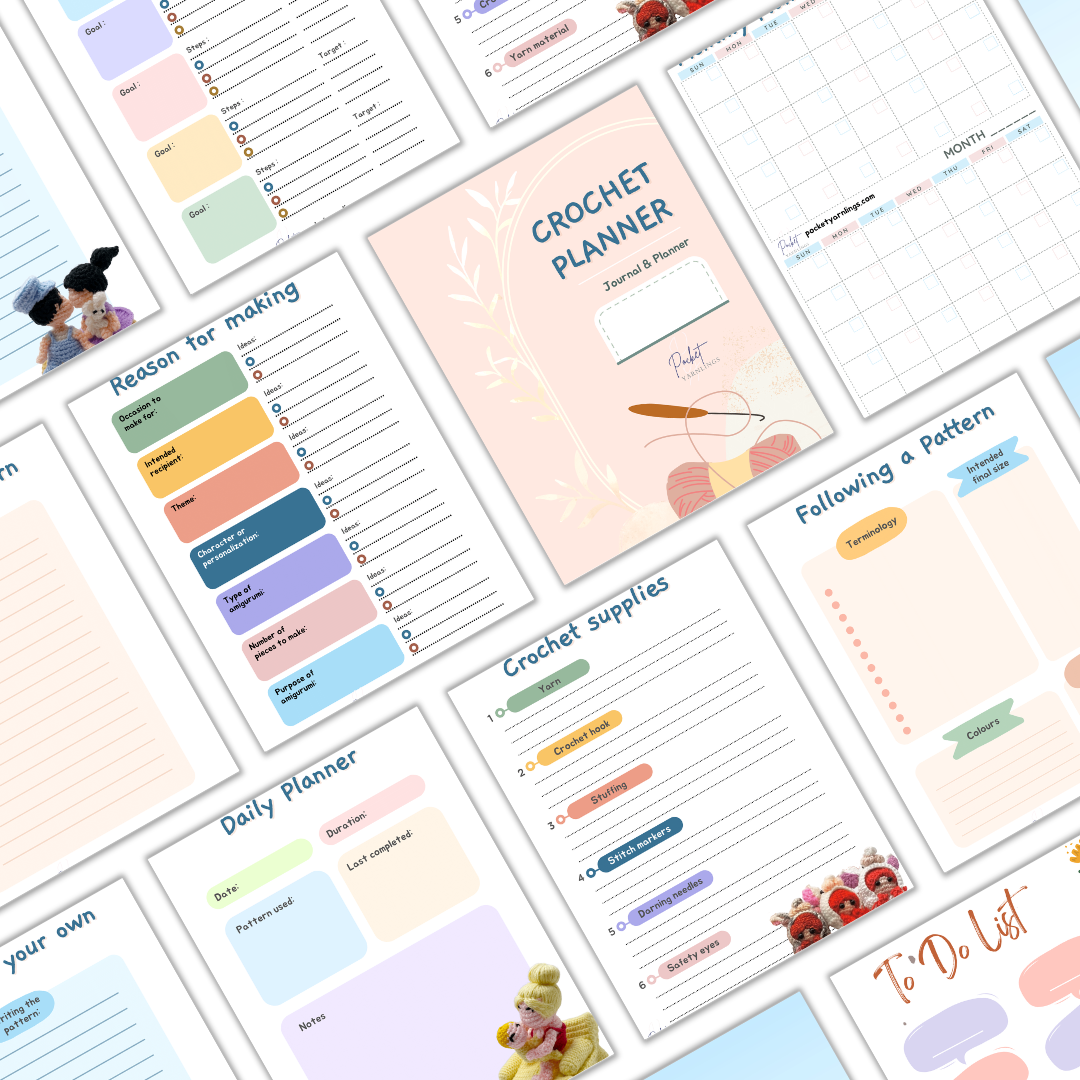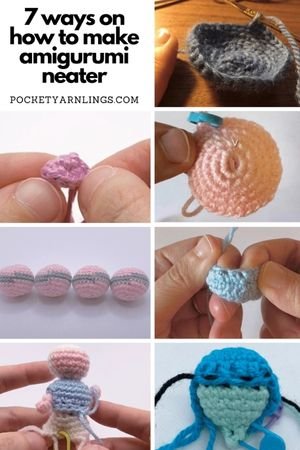Stuffing for Amigurumi: Tips and Tricks for the Perfect Plushie Fill
Do you love crocheting cute little stuffed toys or amigurumi? These adorable creations are often filled with stuffing to give them their shape and texture. But what kind of stuffing is best for amigurumi and also have you wondered how to stuff amigurumi?
No matter which type of stuffing you choose, it's important to consider the safety of your amigurumi. Avoid using materials that could be harmful to children or pets, and make sure that your stuffing is evenly distributed throughout the toy to prevent lumps or unevenness.
With the right stuffing and a little bit of skill, you can create adorable amigurumi toys that are sure to delight anyone who sees them.
Table of Contents Show
There are affiliate links in this post. We will receive a commission if you make a purchase through our affiliate link at no extra cost to you.
Do you put stuffing in amigurumi?
Yes, stuffing is a crucial element in the creation of amigurumi. Amigurumi are crocheted toys, dolls, or animals, and stuffing is used to give them their three-dimensional shape and volume. The stuffing is added to make the amigurumi soft, cuddly, and to give it the desired form.
On the other hand, some amigurumi crocheters choose to crochet loveys for kids, so the head is stuffed but the body is not. There were also instances where I do not stuff my amigurumi limbs especially when the rounds are very small because there was no need to and no space to.
What filling to use for amigurumi?
When it comes to stuffing your amigurumi or crochet animals or dolls, you want to use materials that are soft, lightweight, and hypoallergenic. Here are some options to consider:
Polyester fiberfill or polyfil stuffing is a popular stuffing material because it is widely available, lightweight, soft, and easy to work with. It is also hypoallergenic and machine washable. This is the traditional choice for most amigurumi crocheters.
What is a natural alternative to polyfill stuffing?
Wool roving is another option to consider if you want your amigurumi to have a more natural look and feel. It is soft, lightweight, and can be shaped easily.
Organic cotton batting is a good choice if you want your amigurumi to be eco-friendly. It is soft, lightweight, and hypoallergenic.
Can you stuff amigurumi with yarn?
While yarn is not typically used as the primary stuffing material for amigurumi, it can be used in certain situations for specific effects. Yarn scraps or small pieces of yarn can be employed to add some structure or weight to certain parts of the amigurumi, such as limbs or tails.
However, for the main stuffing of the amigurumi, a softer and more pliable material is usually preferred like polyester fiberfill. This material can be easily shaped and distributed evenly to give the amigurumi its final form. Using yarn as the primary stuffing may not provide the same level of softness and may not hold its shape as well as dedicated stuffing materials.
Can you stuff amigurumi with old clothes?
Yes, it's possible to stuff amigurumi with old clothes or fabric scraps, and it's a sustainable and eco-friendly alternative to traditional stuffing materials. Recycling old clothes for stuffing not only reduces waste but also adds a personal touch to your amigurumi.
Consider cutting it into small manageable pieces, then cleaning and drying it, before adding it as stuffing. Also, consider mixing the old clothes with traditional stuffing, to achieve the desired level of softness.
While using old clothes as stuffing is a creative and sustainable choice, keep in mind that the final result may have a different feel compared to traditional stuffing materials. Experiment with different fabrics and combinations to find the stuffing method that works best for your amigurumi projects.
Can I use cotton balls as stuffing for crochet?
Using cotton balls as stuffing for crochet projects, including amigurumi, is possible but may not be the ideal choice for various reasons. Cotton balls are relatively dense, and their firmness might result in a less soft and cuddly finished product compared to traditional stuffing materials like polyester fiberfill.
Also, it may not distribute evenly within the amigurumi, resulting in lumpy shapes. Consider too that cotton balls might not hold up well to washing for obvious reasons as it can result in clumping.
What can I use instead of stuffing for crocheting?
If you're looking for alternatives to traditional stuffing materials for crocheting, there are those mentioned earlier like old clothes, yarn scraps, cotton or wool. Apart from those, some other alternatives include using recycled pillow filling, tissue paper, packing peanuts, plastic bag, shredded paper or cardboard.
There are other examples that are heavier like using rice or buckwheat hulls to create heavier amigurumi that can stand, which will be explored in further detail below.
When using alternative stuffing materials, consider the washability, firmness, and overall feel you want for your project. It's always a good idea to test a small sample before committing to using a particular material for your entire project.
Remember to pin the image below to Pinterest if you liked this articles so others can check it out too!
What can I put in my stuffed animal to make it weighted?
Weighted amigurumi can enhance stability, allowing the stuffed animals to maintain balance and specific postures more effectively. These weighted creations are also suitable for decorative purposes, serving as unique bookends or doorstops.
There are several materials you can use to achieve this effect, including but not limited to, polypropylene pellets or plastic beads, metal beads, rice, buckwheat hulls or dried beans.
When adding weight to your stuffed animal, it's essential to securely contain the chosen material within an inner pouch or lining to ensure safety, hygiene, and ease of washing. Additionally, consider the overall distribution of weight to maintain the proper balance and shape of the stuffed animal.
Can I stuff plushies with rice?
Dry rice can be used for a cost-effective and readily available option. It adds weight and stability to the amigurumi. However, there are some considerations like making sure to place them in a secure inner pouch to prevent any mess or attracting pests and also to avoid moisture as it can lead to mold growth.
Can I put beans in a stuffed animal?
Dried beans, such as black beans or navy beans, are a cost-effective option, and are less likely to spoil compared to fresh beans. Ensure the beans are clean and free from any debris. Use them in a secure pouch to prevent any potential mess.
Be cautious about exposing the bean-filled stuffed animal to moisture, as it can lead to mold growth. Keep the stuffed animal dry and avoid washing it if beans are used as stuffing.
Free Crochet Planner Journal!
Click here to grab this 20-paged workbook and checklists that will help organize your creativity before you even start on your next crochet project! Or click on image on the left.
How to stuff crochet amigurumi?
After choosing the right stuffing and preparing your amigurumi, start stuffing with small amounts using a stuffing tool. As for when to add the stuffing inside your plushie, I generally choose to add it at the widest diameter or after the initial decreasing stitches when the rounds just start to narrow off. This makes it easier to keep the stuffing in palce.
Make sure you stuff firmly but not too tightly and focus on shaping as you stuff. Remember to fill all parts if you wish to, including any limbs or appendages, then check for lumps or gaps and finally close up the opening.
How much stuffing do you put in amigurumi?
Begin with a small amount of stuffing and gradually add more as needed. This allows you to control the firmness and shape of the amigurumi. Distribute the stuffing evenly throughout the amigurumi to maintain a consistent texture.
Avoid overstuffing as that can make the crochet piece too rigid and affect the overall appearance. You can do this by checking for gaps in the amigurumi.
Also consider the project size as larger amigurumi projects may require more stuffing to maintain their shape, while smaller projects may need less.
How do I know how much stuffing I need?
The amount of stuffing is a subjective preference, so don't hesitate to experiment and find what works best for you. Some crocheters prefer a softer, more cuddly feel, while others like their amigurumi to be firmer.
To determine the right amount of stuffing, start by stuffing a small section of your amigurumi and then squeezing it gently. If the amigurumi feels too soft or squishy, add more stuffing. If it feels too firm or hard, remove some stuffing. Remember that over-stuffing can cause the amigurumi to lose its shape and become lumpy. Under-stuffing can result in a floppy, shapeless amigurumi.
As a general rule, it's easier to add more stuffing if needed than to remove excess stuffing. Take your time, periodically assess the firmness, and make adjustments until you achieve the desired result.
How do you stuff amigurumi evenly?
Some considerations to stuff your amigurumi evenly would be to use small pieces of stuffing at a time to avoid lumps and unevenness, stuff as you go rather than waiting till the very end. Use a stuffing tool to push the stuff into smaller and narrower areas so that the distribution is more even, and mold and shape with your fingers as you go. If you observe one area to be fatter, then mold the stuffing and push it into the narrower areas, and periodically check for empty spaces in the amigurumi.
How to stuff and shape amigurumi?
To create shapes and contours in your amigurumi, you can use different stuffing techniques. For example, to create a round shape, you can stuff the amigurumi tightly in the center and gradually decrease the amount of stuffing as you move towards the edges.
Another technique to create contours is to use wire or pipe cleaners to create a skeleton for your amigurumi. You can then stuff the amigurumi around the wire to create a more structured shape.
How do you keep stuffing from showing through crochet?
The easiest way to achieve this is to simply stuff firmly but overly, but this can be subjective and difficult to assess when you are just starting out. Some other consideration would be adjusting your crocheting techniques and equipment to minimize gaps.
As for crocheting equipment, consider a smaller hook than recommended for your yarn weight and pick a denser yarn, which will help reduce spaces between stitches. Another method is to line the inside with fabric to add an extra layer between the stuffing and crochet stitches.
For crocheting techniques, use tighter crochet stitches like single crochet (rather than double crochet), use invisible decreases, and remember to insert your hook under both loops of the stitch, all of which create a more compact stitch. Finally, remember to secure closures tightly right at the end.
How do you fix overstuffing of amigurumi?
If you've accidentally overfilled your amigurumi with stuffing, don't worry, it's an easy fix. First, try to remove some of the stuffing by gently pulling it out with your fingers or a pair of tweezers. If that doesn't work, you can also try using a crochet hook to pull out the excess stuffing.
If you've already sewn up the hole in your amigurumi, you can still fix the overstuffing by carefully cutting open a small section of the seam and removing some of the stuffing. Then, sew up the hole again.
What stuffing tool for amigurumi?
Use a stuffing tool or the eraser end of a pencil to help push the stuffing into small spaces. Some crocheters use chopsticks but personally I just use the blunt end of a crochet hook because it is convenient. For larger diameter amigurumi projects, you can just use your little finger!
Why do stuffed animals get lumpy?
Stuffed animals may develop lumps over time due to uneven distribution and compression of the stuffing material. Continuous use, handling, and washing can cause the filling to shift or clump together, creating uneven surfaces. Additionally, low-quality stuffing or insufficient stuffing can contribute to lumpy areas.
Why do stuffed animals lose stuffing?
Stuffed animals can lose stuffing over time due to wear and tear, especially if they are subjected to frequent handling, squeezing, or rough play by kids. Seams may weaken or open, allowing the filling to escape.
Poorly stitched or low-quality materials can also contribute to stuffing leakage. Washing stuffed animals improperly, particularly in machines, may cause damage to seams and result in stuffing loss.
Can you refluff an old stuffed animal?
Yes, you can refluff an old stuffed animal to restore its plushness. You might want to do this to breathe new life into an old stuffed animal, making it soft, huggable, and enjoyable for an extended period. This is especially so when you want to keep sentimental toys, in particular old Amigurumis you crocheted for your kids!
How do you make flat stuffed animals fluffy again?
To do this, open a seam or create a small opening, add more stuffing or completely replace the existing filling with new, high-quality stuffing material. Pick an area of the amigurumi where it is easy to see back together, mostly at the attachments or joints.
Ensure that the new stuffing is evenly distributed to avoid lumps. After refilling, carefully stitch or sew the opening closed. Brushing or shaking the fur afterward helps distribute the stuffing and rejuvenate the plush appearance, bringing the stuffed animal back to its fluffy and huggable state.
How do you fix a lumpy stuffed animal?
One way to fix a lumpy stuffed amigurumi is to use a needle and thread to stitch through the lumpy areas and pull them tight. This will help to smooth out the shape.
Another option is to use a technique called "needle felting." This involves using a special needle to compress the stuffing in the lumpy areas and create a more even shape.
If you are unable to redistribute the stuffing so that the stuffed animal is no longer lumpy, it would probably be best to add in new stuffing. Since you are going to opening the seams, you might want to consider to replace all the stuffing inside.
To fix a lumpy stuffed animal, identify the lumpy areas by gently feeling and squeezing the toy. Open a seam in the affected area, carefully remove the uneven stuffing, and replace it with new, evenly distributed filling. Then stitch the seam securely, ensuring the new filling is well-contained and finally reshape and fluff the stuffed amigurumi.
How do you clean stuffed animals without removing stuffing?
To clean stuffed animals without removing the stuffing, start by checking the care label for any specific instructions. If the label allows, spot clean using a mild detergent, water, and a soft cloth or sponge.
Gently scrub the surface of the toy, paying extra attention to soiled areas. Avoid soaking the stuffed animal to prevent water from reaching the interior. Once cleaned, use a damp cloth to remove any soap residue, and allow the toy to air dry completely. For more delicate stuffed animals, consider using a fabric cleaner or a mixture of water and baking soda for a gentle clean.
What is the best filling for stuffed animals?
The best filling for stuffed animals is typically polyester fiberfill. This material is lightweight, hypoallergenic, and maintains its shape well, providing a soft and cuddly texture. It's widely used in the crafting and toy industry due to its affordability, availability, and suitability for various types of stuffed animals. It is also a safe filling for toys meant for children.
What is the cheapest stuffing for amigurumi?
One of the cheapest stuffing options for amigurumi is polyester fiberfill. It is an affordable choice for filling stuffed animals and toys. This is if you choose to specifically buy stuffing for your amigurumi. On the other hand, there are “cheaper” options like recycling and repurposing other household items to be used as stuff, which is mentioned in the next section.
How to make your own toy stuffing?
You can make your own toy stuffing by repurposing materials you might have at home. One common DIY stuffing option is using old, clean fabric scraps or clothing. Cut the fabric into small pieces or strips, ensuring they are free of buttons, zippers, or any hard elements.
Another option is using shredded magazine pages or tissue paper, though this may provide a less plush feel. Ensure that the chosen materials are clean and safe for use in toys. Keep in mind that while these DIY alternatives can be cost-effective, they may not offer the same resilience and softness as commercial toy stuffing materials.
Where to buy stuffing for crochet?
You can buy stuffing for crochet, commonly known as toy stuffing or fiberfill, from various retailers. Here are some places where you can find it:
Craft Stores: Visit local craft stores like Michaels, Joann Fabrics, or Hobby Lobby. They usually carry a variety of stuffing options for crochet projects.
Online Retailers: Websites such as Amazon, Etsy, and eBay offer a wide range of stuffing materials. You can find different types, sizes, and brands suitable for crochet projects.
Specialty Yarn Shops: Some specialty yarn shops or stores dedicated to amigurumi and crochet supplies may carry specific types of stuffing suitable for crochet projects.
Big-Box Stores: Large retail stores like Walmart or Target may also have a crafting section where you can find basic stuffing options for crochet.
Conclusion for Stuffing for Amigurumi
In conclusion, choosing the right stuffing for amigurumi is essential for creating adorable, soft, and huggable toys. Whether using traditional choices or even repurposing household items, the key is to prioritize safety and consider the desired texture. When stuffing, focus on even distribution, shaping as you go, and adjusting firmness according to personal preference. With the right stuffing and techniques, you can craft delightful amigurumi that captivate and charm.
Free Crochet Planner Journal!
Click here to grab this 20-paged workbook and checklists that will help organize your creativity before you even start on your next crochet project! Or click on image on the left.
Related Resources
Best Crochet Hook for Amigurumi and 12 ways for Choice Selection
Crochet Hook Size Chart for Amigurumi: Absolutely Everything You Need to Know
12-point Checklist to Select the Best Yarn for Amigurumi
Yarn Weight Chart for Crocheting: Ultimate Comprehensive Detailed Guide
My Crochet Tools and Accessories that are Super Simple to Start With
10 Crochet Stitch Marker Types and their 10 easy Uses in Amigurumi

















